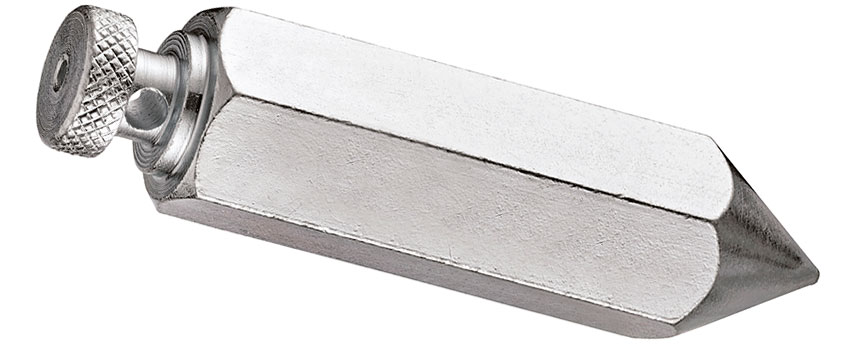

The combination of claim 1, wherein the forward portion of the interior cavity has a length coaxial with the sheath longitudinal axis that is less than or equal to ⅝ inch so that a tool with a pointed member longer than ⅝ inch will not slide into the sheath far enough forward to allow the latch to extend into said recess of the tool body to lock the tool in the sheath.Ĩ. The combination of claim 1, wherein the sheath cavity wall has a slot through which said string passes from the forward portion of the interior cavity to outside the sheath.ħ. The combination of claim 1, wherein the sheath further comprises a base with a planar outer surface adapted for attachment to a chalk box.Ħ. The combination of claim 3, wherein the lock member integrally extends from the cavity wall, and the lock member pivots in said plane passing through said sheath longitudinal axis by means of a portion of the cavity wall to which the lock member is connected flexing in direction parallel to said plane.ĥ. The combination of claim 1, wherein said tool body has a rear end, and a tool longitudinal axis between the front end and the rear end, a side surface generally parallel to the tool longitudinal axis, and said recess is in said side surface, and wherein the forward portion and rearward portions of the interior cavity and the opening are aligned generally coaxially on the sheath longitudinal axis, and the locking system comprises a lock member connected to the cavity wall extending generally parallel to the sheath longitudinal axis and pivotal in a plane passing through said sheath longitudinal axis, wherein a rearward end of the lock member is said latch and the lock member is biased to pivot the latch toward the sheath longitudinal axis rearward of said opening.Ĥ. The combination of claim 1, wherein said rearward portion of the interior cavity has a limiting surface near said forward portion of the interior cavity, and, when the tool is received in the sheath, the tool body abuts against said limiting surface to limit forward movement of the tool in the interior cavity, and the pointed member extends into the forward portion of the interior cavity.ģ. A sheath and string-line tool combination comprising: a tool having a tool body with a front end and a recess, a pointed member protruding from the front end, and a string having a first end and a second end, the first end being attached to the tool a sheath having a sheath front end and a sheath rear end, a longitudinal axis between said sheath front end and said sheath rear end, a cavity wall surrounding and defining an interior cavity with an opening receiving the tool, wherein the interior cavity has a forward portion receiving the pointed member and a rearward portion receiving at least a part of the body of the tool a locking system adapted to releasably lock the tool in the sheath, the locking system comprising a latch that is biased to extend into said recess of the tool body to prevent removal of the tool from the sheath.Ģ. This plumb line is important for lining up anatomical geometries and visualizing the subject's center of balance.1. The device used may be purpose-made plumb lines, or simply makeshift devices made from a piece of string and a weighted object, such as a metal washer. Students of figure drawing will also make use of a plumb line to find the vertical axis through the center of gravity of their subject and lay it down on paper as a point of reference.

Ī plumb bob may be in a container of water (when conditions are above freezing temperatures), molasses, very viscous oils or other liquids to dampen any swinging movement, functioning as a shock absorber.ĭetermining center of gravity of an irregular shape The early skyscrapers used heavy plumb bobs, hung on wire in their elevator shafts. A variation of this tool has the plumb line hung from the top of an inverted T shape. An A-frame level with a plumb line hung from the vertex was also used to find horizontal these were used in Europe until the mid–19th century. However, if they are mounted on a suitable scale the instrument may also be used as an inclinometer to measure angles to the vertical.Īncient Egyptians used a plumb line attached to the top outer part of a tool resembling a letter E when placed against a wall, the plumb line would indicate a vertical line. A plumb bob and line alone can determine only a vertical reference.


 0 kommentar(er)
0 kommentar(er)
